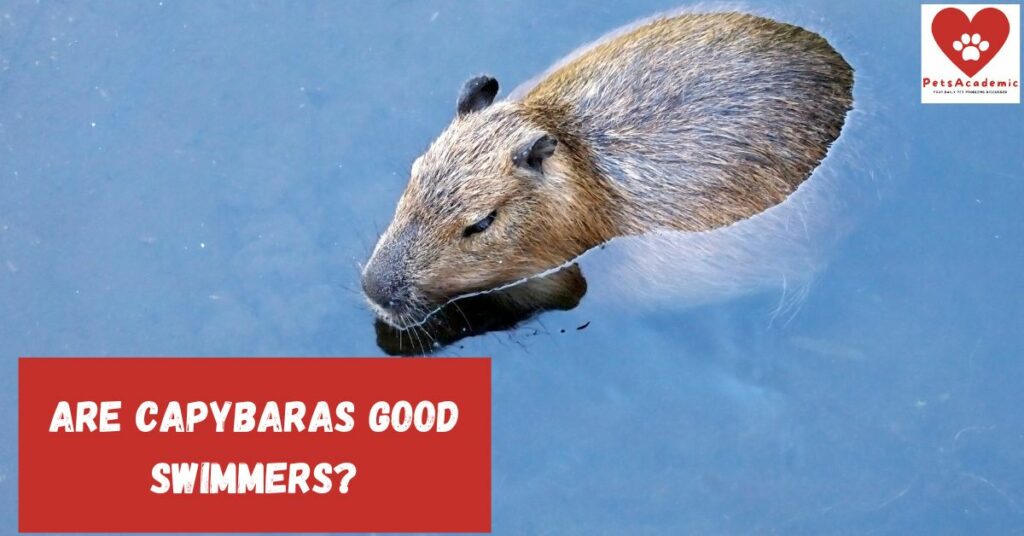Capybaras are the largest rodents in the world, weighing up to 140 pounds. They are social animals and live in large groups that can reach up to 100 individuals.
Capybaras are excellent swimmers. They spend much of their time in the water and can even sleep while floating in the water.
Capybaras have webbed feet that help them to swim quickly and gracefully up to a speed of 30 kilometres per hour.
They also have a layer of protective fat under their skin that keeps them warm and helps them to survive in cold water.
In this article, we are going to delve deeper into the swimming capabilities of capybaras and explore some interesting facts about their aquatic lifestyle.
Are Capybaras Good Swimmers?

Capybaras are excellent swimmers!
They have webbed feet and flattened tail that helps propel them through the water.
Their short, stocky build is also advantageous when it comes to swimming, as they can easily stay close to the surface instead of fighting against strong currents deep underwater.
Capybaras can reach speeds up to 30kph in the water and can stay submerged for up to five minutes at a time!
They are also able to use their muzzle as a snorkel when needed, allowing them to take quick breaths while underwater.
With these impressive swimming abilities, it’s no wonder that many Capybaras enjoy taking a dip in the lake or river.
Do Capybaras Swim In Cold Or Hot Water?

Capybaras are semi-aquatic rodents native to South America.
They love swimming and can spend hours in the water! But when it comes to temperature, do they prefer cold or hot water?
Capybaras actually enjoy and prefer hot temperatures while swimming! This is because they come from areas with hot, tropical climates, and they are more comfortable in water that is warmer than at room temperature.
Capybaras also prefer slow-moving waters, such as shallow lakes and ponds, rather than fast-flowing rivers or streams. While they do enjoy swimming in cold water occasionally, it’s not something that they normally seek out.
So if you want to give your capybara a special treat on a hot summer day, why not take them for a dip in some warm, shallow water? They’ll be sure to thank you for it!
Where Can You Find Capybaras In The Wild?

Capybaras are found throughout much of South America, primarily in lowland areas near water sources such as rivers, lakes and ponds. They also inhabit marshes, swamps and flooded savannas.
Capybaras occupy an extensive range that spans from Venezuela to northern Argentina and Uruguay.
They are quite adaptable and can even live in some agricultural areas.
Capybaras can be seen in the wild in national parks such as Pantanal National Park and Tumucumaque Mountains National Park in Brazil.
They can also be spotted in Iguazú National Park, an area of jungle and waterfalls along Argentina’s northern border with Paraguay and Brazil. A trip to these wild areas can be a great way to get an up-close look at capybaras in their natural habitat.
Can Wild Capybaras Dive?

Capybaras are excellent swimmers and can easily submerge underwater. They spend much of their time in the water, browsing for food like aquatic plants or searching for predators.
Some capybaras have even been observed diving as deep as four feet below the surface! The webbed feet of a capybara help them swim quickly and steadily, making them great swimmers.
They usually stay on the top of the water and take a dive, mostly when they feel a threat from predators like jaguars and anacondas. Capybaras can also use their facial whiskers to sense prey and predators from afar.
Can Capybara Hold Breath Under Water: Swimming Of Capybaras!

Capybaras can definitely hold their breath underwater! They are excellent swimmers, and they can usually stay submerged for up to five minutes.
If you ever get the chance to watch a capybara swimming in its natural habitat, you will see how graceful and at ease it is underwater. Their webbed feet make them extra agile, and they use their strong hind legs to help them swim.
Capybaras can also stay underwater for longer periods of time if needed, as it is thought that they will hold their breath for up to 10 minutes when feeling threatened. This ability can be a great asset in the wild, where the capybara needs to evade potential predators.
Frequently Asked Questions Related To Capybara Facts About Swimming
1. Is capybara water resistant?
The capybara is an amphibious animal, which means its skin is waterproof. This helps the capybara stay hydrated when it’s in water and protects it from predators when it’s in the water or on land.
Capybaras have very oily skin, which also helps protect them from the sun and parasites.
2. How deep can Capybara dive?
Capybaras can dive about 4 feet below the surface of the water to evade predators or retrieve hidden food. They are also good swimmers and can stay underwater for up to five minutes.
3. Where do Capybara mostly live?
Capybaras live near water sources such as rivers, lakes, ponds, marshes and swamps. They are excellent swimmers and divers and love to play in the water.
They also like to wade in the shallows and eat the vegetation that grows there.
Capybaras are diurnal animals, which means they are most active during the day. At night they retire to a sheltered spot on land where they can safely rest.
Conclusion On The Fact That Capybaras Can Swim
In conclusion, it is evident that capybaras are natural and adept swimmers.
These giant rodents are not only able to swim but also prefer it as their primary means of locomotion in the water.
Similar to their smaller relatives, guinea pigs, capybaras possess strong swimming abilities right from birth.
Unlike other animals that need to learn to swim, capybaras are born with the skill and instinct to navigate through water effortlessly.
One fascinating aspect is that capybaras can even submerge themselves underwater and breathe comfortably.
This unique ability sets them apart from many other mammals and allows them to stay submerged for extended periods.
Capybaras are also capable of swimming at a speed of about 10 miles per hour, making them exceptionally fast for their size.
Therefore, if you ever have the opportunity to swim with a pet capybara or observe them in their natural habitat, you can be certain that they will be just as comfortable in the water as they are on land.
Related Posts: Are Capybaras Legal in Oklahoma?

